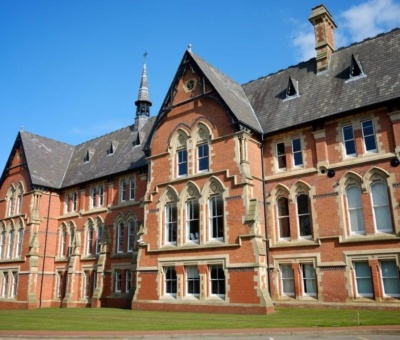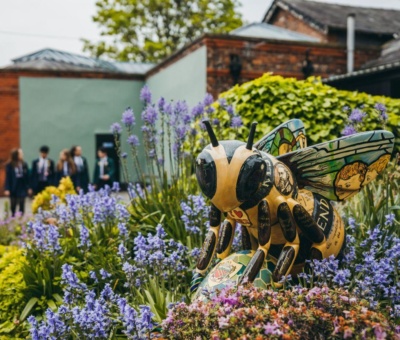Life in Lockdown: Look Around
Welcome to the Head’s blog. Here you will find a message from the Head and a playlist to enjoy.
During the course of the last week or so, I have dusted off my bike and started to use it for my permitted dose of daily exercise. As I have cycled around the local area, I have been surprised by just how much I had missed sights which previously I had not really paid that much attention to. It also set me thinking about the importance of place, and how far we are products of where we were brought up, or where we live.
I wonder how many of you ever stop to think about your identity, and what it is that makes you who you are? Is it your place of birth, your family history, your religion, your allegiances, where you live now? For many of us, where we are from forms a central part of our identity. Just think about the labels which are used to describe different people, so many of them allude to place: ‘scouser’, ‘cockney’, ‘brummie’, ‘manc’. And with those labels come generic characteristics, which I’m sure we can all think of when recalling people we have met from those different places.
However, one of the most exciting features of any place or community is the way in which it not only absorbs new members, but also adapts to reflect characteristics, cultures, experiences of these new members. In this way, many aspects of a community therefore evolve over time, a phenomenon which has been taking place for thousands of years. Next time you are in central Manchester, why not research the site of the Roman fort, and then consider why the Romans left, and who replaced them. What did Celts, Romans, Saxons, Vikings, Normans leave behind to make us who we are?
Take dialect, as an example. It has always intrigued me how people who live barely 40 miles from each other can convey the same language in such different ways, with contrasting tones, accents, even words unique to that area. Equally, how can regional accents remain so resistant to change when we are swamped by what appears to be universal Anglo-Americanisms transmitted over the radio, on social media, TV, film etc?
With all this in mind, next time you walk around your local area why not consider how it was formed and how far your approach to life and who you are has been shaped by it.
In what may appear to be the product of a carefully-planned link between the text and playlist, this week’s tracks all have a strong(ish) link to Stockport, the borough in which CHS resides.
Head’s playlist 4:
‘Life is a Minestrone’ 10cc
10cc were session musicians at Strawberry Studios in Stockport before deciding to take it over and then turning it into one of the most highly sought after recording studios in the country. As well as all of their early albums, the studio saw artists as diverse as Paul McCartney, Joy Division, The Smiths, The Stone Roses, and er Neil Sedaka record there.
‘Jelly Baby’ World of Twist
World of Twist were one of the great lost artists of the early 1990s, between ‘baggy’ and Britpop. This is taken from their only album. Cheadle Hulme-based singer Tony Ogden was the principal songwriter and singer.
‘The Look of Love-Pt 1’ ABC
Along with World of Twist, ABC are frequently and erroneously labelled as just being a Sheffield band. In fact, frontman Martin Fry grew up in Bramhall. Coincidentally, his brother later joined an offshoot of World of Twist, Earl Brutus. In case you’re interested.
‘Elstree’ Buggles
Too easily dismissed as a novelty one-hit wonder, Buggles (duo Geoff Downes and Trevor Horn) created really inventive pop before they were briefly co opted into prog rockers Yes and then going their separate ways to join US FM radio monsters Asia (Geoff Downes) and becoming the most in-demand producer of the 1980s and early 1990s (Trevor Horn). What’s the link with Stockport? Geoff Downes attended a Stockport-based co-educational independent day school which isn’t CHS.
‘Living in a Box’ Living in a Box
Richard Darbyshire was born in Stockport, spent a brief period in the US and then attended a Manchester-based single sex independent day school.
‘Uprising’ Muse
Nothing says Muse more than this piece of bombastic, moody, driving rock. Their drummer, usually seen barricaded by a 127 piece drum kit, Dominc Howard, was born in Stockport before fleeing on a UFO to Devon where he joined an alien cult led by the imperious guitar Riff Lord, Matt Bellamy. (I think Muse may need to proof read their Wikipedia page.)
‘Biology’ Girls Aloud
One of the great and ambitious pop singles, probably overlooked by some as merely the product of a talent show girl band riding out the last throes of success. Sarah Harding attended a Bramhall-based co-educational high school.
‘Two Tribes’ Frankie Goes To Hollywood
Surely, Frankie are so steeped in Liverpool that there can be no possible link to Stockport? Stick with me on this one, as Frankie owed much of their success to the sharply crafted narrative and image created around them, including some of the most interesting sleeve notes you are ever likely to read on a record. This image, and those sleeve notes were written by one of the founders of their record label, ZTT, Paul Morley. Morley grew up in Reddish Vale before heading to London to write for the NME.
‘Steppin’ Out’ John Mayall and the Bluesbreakers
Father of the 1960s British blues explosion, John Mayall was born in Macclesfield and later lived in Cheadle. This track is taken from arguably his most well-known album and highlights the talents of the phenomenal line up at his disposal at this time. Eric Clapton, Mick Fleetwood and John McVie (later of Fleetwood Mac) were all members of the Bluesbreakers on this album.
‘Going for Gold’ Shed Seven
Lead singer Rick Witter was born in Stockport before looking for the streets literally paved with gold in York, a journey he recounts in this middling Britpop song.


